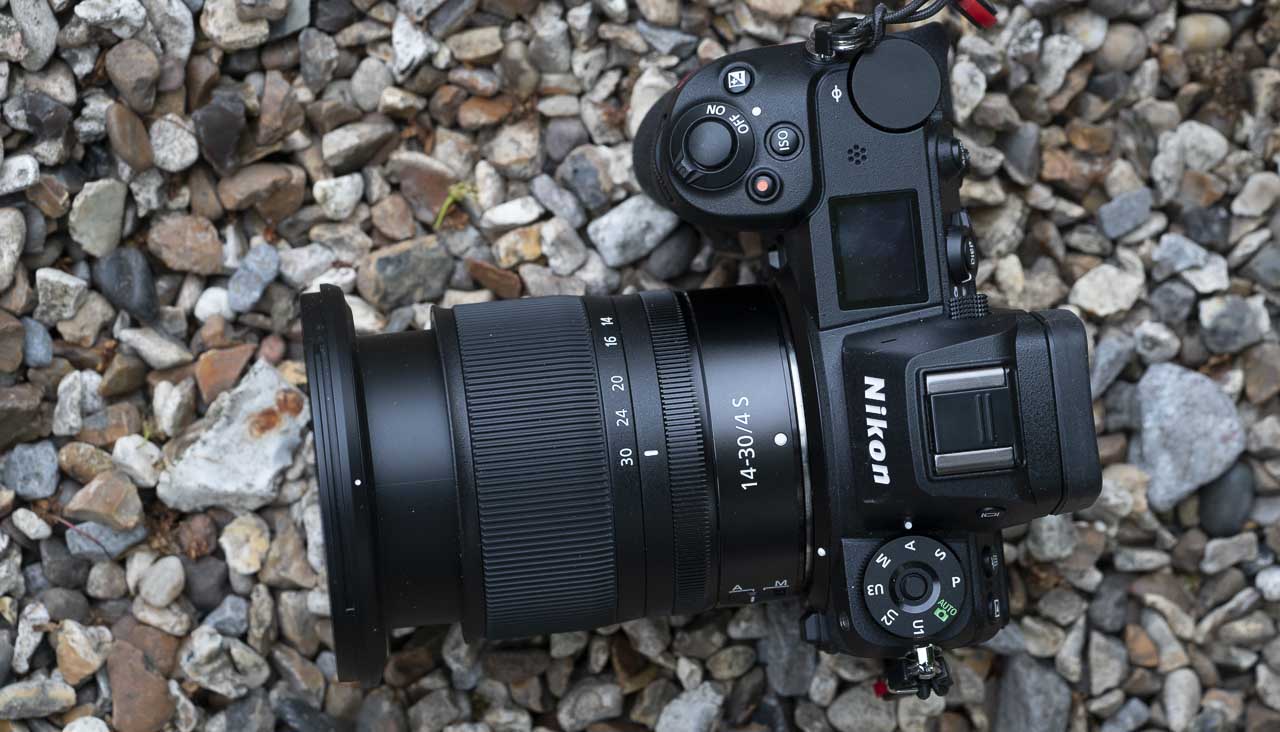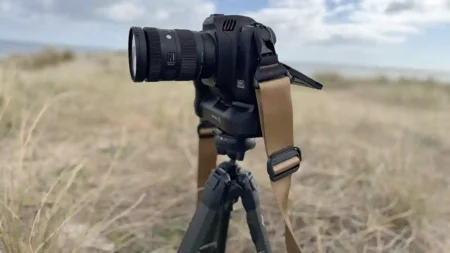The Nikon Nikkor Z 14-30mm f/4 S is the widest Nikon Z lens currently available for Nikon’s full-frame mirrorless cameras, the Z6 and Z7. It’s small and light for such a wide-angle full-frame lens, but it’s capable of delivering some very impressive results.
- Check the price of the Nikon Nikkor Z 14-30mm f/4 S at Amazon UK, Wex Photo Video, Park Cameras, Adorama, BH Photo Video
The Nikon Z 14-30mm f/4 S is constructed from 14 elements in 12 groups. Amongst these elements, there are 4 extra-low dispersion (ED) elements, 4 aspherical elements and an unknown number of elements with Nikon’s Nano Crystal Coat. The front element is fluorine-coated to help keep fingerprints, water droplets and dust at bay.
Like the Nikon Z6 and Z7, the lens is also sealed against dust and water droplets.
The Nikkor Z 14-30mm f/4 S is also the first full-frame ultra-wide-angle lens to have standard (82mm) filter thread. That’s especially useful for anyone who is shooting video and needs to use ND filters. Of course, it’s also handy when you want to shoot long exposures during the day.
As well as having a fixed maximum aperture of f/4, the 14-30mm S can focus as close as 28cm throughout its entire zoom range.
Key Specifications
The 14-30mm is a full-frame lens with the Nikon Z mount. It also has a fixed maximum aperture of f/4. Opting for f/4 rather than f/2.8 helps to keep the size of the lens down while still allowing fast shutter speeds to be used in moderately low light.
There’s no stabilisation built in to the lens, but the Nikon Z6 and Z7 both have in-body image stabilisation (IBIS).
- Format: FX/35 mm
- Focal length: 14–30 mm
- Maximum aperture: f/4
- Minimum aperture: f/22
- Construction: 14 elements in 12 groups (including 4 ED elements, 4 aspherical elements, elements with Nano Crystal Coat, and a fluorine-coated front lens element)
- Angle of view: FX format: 114° to 72°, DX format: 90° to 50°
- Focal length scale: 14, 16, 20, 24, 30mm
- Focusing system: Internal focusing system
- Minimum focus distance: 0.28 m (0.92 ft), from focal plane at all zoom positions
- No. of diaphragm blades: 7 (rounded diaphragm opening)
- Coating: Nano Crystal Coating, Fluorine coating
- Filter size: 82 mm
- Diameter x length (from lens mount): 89 mm max diameter x 85 mm (when lens is retracted)
- Weight: 485 g (1 lb 1.2 oz)

Build and Handling
Opting for a maximum aperture of f/4 means that Nikon has kept the size of the 14-30mm lens down in comparison with an f/2.8 optic. In fact, when the lens is retracted, it only extends 85mm from the camera body. Its maximum diameter is 89mm, although the lens hood takes that to around 104mm by my measurement.
For comparison, the AF-S Nikkor 14-24mm f/2.8G ED measures 98 x 131.5 mm and weighs 1Kg, more than double the 485 weight of the 14-30mm Z lens.
Nikon has used a retractable lens mechanism for the Z 14-30mm f/4 S. This means that it can be collapsed down to take up a little less space in your bag, but you need to rotate the zoom ring to the 14mm point (or further) to prepare the lens for use. You get a reminder on the screen if you turn on the camera before the lens is extended.
Generally, the lens has a high-quality feel, but that’s little diminished by the collapsing mechanism. It feels like you’re forcing the lens around. An electronic release that activates when the camera is powered-up would seem more sophisticated, though it would add to the cost. A release catch might offer another solution, but that would make extending the lens a two-step process, so perhaps Nikon has opted for the best solution.
Control Rings
The wide zoom ring sits towards the end of the lens, and once it’s extended, it has a smooth action. Less than a quarter of a turn of this ring takes you from one end of the zoom range to the other.
The manual focus ring sits closer to the lens mount. This is quite narrow but has a smooth action. It’s an electronic control which means that there’s no end point for the rotation. However, the manual focus indicator in the viewfinder makes it clear when the extreme ends have been reached.
Helpfully, the manual focus ring can also be set to adjust aspects such as the aperture or exposure compensation. I like to use it for controlling exposure compensation. The middle finger of my left hand aligns perfectly with the ring when I’m supporting the camera and it only takes light pressure to adjust the setting.
If you switch to manual focusing, the ring reverts to its focusing duty.
Performance
I tested the Nikon Nikkor Z 14-30mm f/4 S on the Nikon Z7, the higher-resolution of Nikon’s two full-frame mirrorless cameras.
The Z 14-30mm f/4 S captures lots of detail with excellent sharpness across the frame. Naturally, there is a slight dip in resolution towards the far corners of the frame when the aperture is wide-open. As you’d expect, this is more apparent at the widest focal length, but it’s not bad at all. Closing down to f/5.6 and f/8 sharpens up the corners.
At 30mm, the difference in the corner sharpness as the aperture closes is only evident when you’re pixel-peeping.
This sharpness is maintained well up to f/16, but the impact of diffraction starts to become more apparent at f/22. The centre of the image is sharpest at f/5.6, but f/8 isn’t far behind, and it gets a little more corner sharpness at 14mm.
The stepping motor that drives the lens’ focusing is very quiet. If you’re shooting video outside with a little breeze or birdsong, you may well not notice it in your video. It’s also fast and efficient for stills shooting.
Distortion, aberration and Vignetting
Shooting a brick wall reveals that Nikon has done an impressive job with distortion control with this lens. Even at the 14mm end, the lines of mortar hardly seem to bow.
Vignetting also isn’t a significant issue, but it is visible at f/4 in images shot at the widest point of the lens. However, it’s quickly dealt with by switching the Vignette Control to its high setting or closing down the aperture. Closing to f/5.6 reduces the corner shading significantly and by f/8 you’re unlikely to notice it.
Alternatively, you can brighten the corners of raw files during their processing, but I don’t find it objectionable anyway.
As before, I noticed some chromatic aberration in the viewfinder of the Z7 while shooting with the Z 14-30mm f/4 S, but this doesn’t appear on the images, it’s an issue with the viewfinder.
Happily, the lens controls chromatic aberration very well even when there are backlit subjects towards the corners of the frame.
Sample Images
These images were shot on the Nikon Z7.
Browse and download full-resolution images
Verdict
If you’ve used the AF-S Nikkor 14-24mm f/2.8G ED, the Nikon Z 14-30mm f/4 S seems like a baby of a lens in comparison. However, it has a greater zoom range and it’s easier to use with filters. Its collapsible design also makes it a little more portable than it might otherwise be.
Nikon has promised a Nikkor Z 14-24mm f/2.8 S next year, and while that may be better for shooting in low light, it’s likely to be much bigger and heavier than the 14-30mm f/4. That means it may not be quite so nicely balanced on the Z6 and Z7 as this 14-30mm f/4.
Most people buy a wide-angle zoom lens for the wider focal length. The 14mm end of this lens provides an interesting perspective and it’s a useful tool for landscape and interior photography.
Importantly, the Nikkor Z 14-30mm f/4 S keeps distortion, vignetting and chromatic aberration under control very well. It also captures a good level of detail throughout the focal length range.
- Nikon launches instant summer savings scheme
- Check the price of the Nikon Nikkor Z 14-30mm f/4 S at Amazon UK, Wex Photo Video, Park Cameras, Adorama, BH Photo Video



